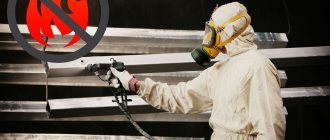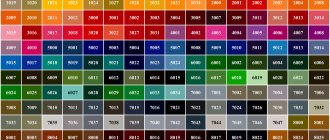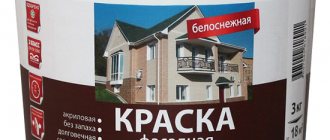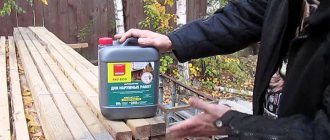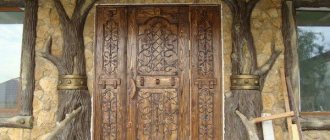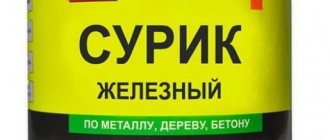Wood is the material most often found in modern buildings, be it a country house or an apartment in a multi-story building. And, as you know, wood is very flammable. In 2014, about 6,000 fires were officially recorded in Moscow alone. The cause of a fire can be anything: bad or old electrical wiring; a cigarette butt thrown past the ballot box; the carelessness of a drunk neighbor. No one is safe from fire. And if it’s difficult to deal with drunk neighbors, then there are a number of ways to somewhat reduce the extent of the damage and prevent the fire from spreading. Special fire-retardant varnishes and paints can become such a fire barrier.
What are the benefits of painting wood with fire retardant paint?
Any material exposed to fire changes its properties - to what extent, it all depends on the duration of contact and the temperature of the flame. Therefore, in fire safety categories, the emphasis is not on the flammability of materials as such, but on their ability to resist fire for a certain time (during which it is possible to respond to a fire and take appropriate measures, or at least evacuate).
That is, if you treat wood with a fire retardant compound, then you should not expect that the wood will not react to a gas burner (which melts metal). But you can be sure that the wood will not catch fire if, for example, a spark gets on it, or a burning paper or rag falls.
Another advantage that can be obtained is additional protection of wooden surfaces treated with fire retardant from insects, rot and other biological factors. Of course, if the manufacturer has added the necessary components to the composition.
Characteristics of fire retardant paint NEOMID Source neomid.ru
The need for fire protection
Protecting wood from fire is the main fire safety requirement for every building or structure, no matter during direct construction or during operation. The standards set out in local and regulatory documents must be observed, otherwise the facility will not be put into operation. This is a mandatory condition for specialized construction organizations.
When building a private house, any owner must also provide fire protection for wooden structures; this requirement is not in vain.
Fire impregnation of wood is carried out at the following intervals:
- before putting the facility into operation;
- every 5 years;
- as necessary, if during operation the properties of the impregnation do not provide protection.
The latter can be checked very simply: you need to remove a small section of chips and set it on fire and, accordingly, if a fire occurs, treatment with a fire retardant is necessary.
Fire protection of a wooden base is a measure to ensure fire safety requirements that must be followed throughout the entire Russian Federation.
List of wood processing methods:
- Carrying out finishing work using special fireproof materials.
- Measures to increase the fire resistance limit.
- Fire-retardant impregnation for wood using paint and varnish coating.
- At the design stage, it is chosen which method to apply to a particular design. The inspection is carried out by a representative of the fire service.
Fire retardant treatment is required for the following elements:
- rafter structures (load-bearing and non-load-bearing);
- timber walls;
- coatings and floors;
- beams;
- shingles for plaster;
- wooden panels inside and outside;
- other wooden surfaces.
On video: fire retardant wood treatment.
Composition of fire retardants
To simplify the operating principle of a fire retardant as much as possible, it is a non-flammable substance dissolved in water. After wetting the wood, the water evaporates, and the fire retardant remains in its fibers and begins to act in case of contact with fire.
NEOMID is a manufacturer of more than just fire-retardant interior paint. The company’s facilities produce a wide range of construction chemicals – from narrowly targeted ones to broad-spectrum formulations. That is, if it is possible and it has a minimal impact on the final cost, the experience of the developers allows us to expand the functionality of the product.
In particular, when creating fire-retardant paint, in addition to a suspension of pigments and standard fire retardants, active antiseptic components, as well as intumescent compositions, were added to the composition. We will consider the role of the latter in the section where we will analyze the principle of operation.
The manufacturer also guarantees the absence of chemicals prohibited in the EU and the Russian Federation.
Odorless paint is produced for indoor work Source neomid.ru
Rogneda Pyrex Metal Plus - heat-resistant heat-resistant paint for metal
Fire-resistant organic polymer paint for metal Rogneda Pyrex Metal Plus increases the fire resistance of metal structures of objects for any purpose (residential buildings, industrial buildings, public buildings). Painting work can be performed in low temperature conditions (down to -20°C). The paint is economical: it has low consumption and can be purchased at an affordable price.
Rogneda Pyrex Metal Plus forms an aesthetic and durable matte coating. Multi-layer painting is allowed until the required thickness of the dry layer of heat-resistant paint for metal is achieved. There is the possibility of both machine tinting from catalogs and manual tinting using tinting pastes.
Where is fire retardant interior paint used?
The vast majority of those who build a wooden house strive to leave the structure of the wood as open as possible. There is a well-known saying that there is no point in building a wooden house and hiding it behind the finishing... Therefore, the average person has little idea why fire-retardant paint is needed if the wood can simply be treated with a fire retardant.
The solution here is extremely simple - in every home there are flammable places that need additional protection, for example, a kitchen stove. If you have a fireplace built, then special fire safety measures are simply a must have for a thrifty owner who is thinking about his home for several years in advance. Plus, paint is simply necessary if you need to protect a surface made of a poorly absorbent material from fire, or when there is a risk of subsequent leaching of fire-retardant components from the wood.
NEOMID fire-retardant interior paint solves several issues at once. In addition to directly protecting surfaces from fire, it allows you to do it beautifully. Plus, if over time you want to change the shade, or the wall gets dirty, then fixing it will be much easier than in the case of exposed wood.
Of course, if you need to protect, for example, joists or rafters from fire, then it will be enough to simply treat them with NEOMID 450-1 transparent fire protection, but if the surface is in a visible place, then you need to choose paint.
Fire and bioprotection NEOMID 450-1 Source neomid.ru
By the way, what kind of paint is used is also important when developing fire escape routes... But we will tell you more about this in the section about differences from conventional paints.
Pirilax-Prime
Price: 232.6 rub.
Fire retardant impregnation with an antiseptic effect for wood Biopyren "Pirilax"-Prime is used as fire protection for interior and exterior work. Externally, the product is a viscous, transparent, yellow liquid. The product is intended for fire retardant and antiseptic treatment of wood before applying paints and varnishes. More details Quick order Add to cart
Properties and principle of operation
Fire retardant interior paint NEOMID has the following properties:
- Odorless as the composition is water based.
- Creates a matte decorative coating on the painted surface.
- The composition contains active additives that protect wood from rot, mold and other biological damage.
- The service life of the paint is 10 years. The paint is interior paint, so painted items and surfaces should be used inside the house.
- Protects both from fire and from the spread of fire.
- After painting, the surface acquires the first (highest) group of fire retardant efficiency, in accordance with GOST R 53295-2009.
- Suitable for painting wood, plywood, chipboard and fiberboard.
The operating principle of NEOMID fire retardant paint is based on the presence of intumescent compositions. When exposed to fire on a painted surface, the paint swells and forms a heat-insulating layer that stops the combustion process.
If the fire is localized in time, then the surface affected by the flame, in most cases, will only need to be repainted.
What types of paints and enamels are there for batteries, radiators and hot pipes?
Alkyd enamels and paints, as well as heat-resistant acrylic-based compounds, are most often used for painting radiators and heating pipes. As a rule, they can also be used to cover metal, wood and mineral surfaces that are constantly exposed to high temperatures (sections of the internal walls of the house under which the chimney is hidden, radiator niches and others).
Heat-resistant acrylic enamels for painting radiators and heating pipes - odorless compositions. They dry quickly and retain color well. Many people are concerned about the cost of paint for batteries. The price for acrylic compositions is slightly higher than for alkyd ones, but this difference is not so significant, given the long period of operation of the resulting coatings. For acrylic enamels for radiators, we recommend buying Alpina Heizkorperlack, Dufa Heizkorperlach.
As for alkyd enamels and paints for cast iron batteries and hot pipes , they are also resistant to high temperatures and do not wear off or crack during use. Among the disadvantages of such compositions, it is perhaps worth mentioning the gradual yellowing of the coatings obtained as a result of their use, but this applies to a greater extent to cheap low-quality products. Good alkyd paints for pipes and batteries of high quality do not lose their original shade for a very long time. We suggest using the following alkyd enamels: Dufa Aqua Heizkorperlach, Tex Profi. This is an ideal choice for pipes and heating radiators: the compounds dry quickly, are easy to apply, do not turn yellow or crack.
We remind you that you will always find great deals on fire-resistant, fire-resistant heat-resistant (heat-resistant) paints for metal, wooden surfaces, stoves and barbecues, metal structures, for radiators, radiators or hot heating pipes in the Arlind online store. You can buy Tikkurila, Rogneda, Neomid products from us at low prices with delivery in Moscow and Russia.
What about the documents...
All NEOMID products undergo regular mandatory certification for compliance with the necessary fire safety standards. In particular, fire protection received a certificate of conformity confirming that NEOMID 450-1 was created in accordance with TU 2499-048-98536873-2009 and received I (first) group of fire retardant efficiency. Remains resistant to aging provided the application rate is at least 250 g/m². Also, fire protection corresponds to the II (second) group of fire retardant efficiency, provided that it is applied in an amount of at least 150 g/m².
Fire retardant interior paint NEOMID complies with the technical regulations on fire safety requirements in accordance with Federal Law dated July 22, 2008 No. 123 FZ according to GOST R 53292-2009 (clauses 5, 6.1, 6.3) Fire retardant compositions and substances for wood and wood-based materials .
The tests were carried out according to the methods approved in the Order of the Federal Agency for Technical Regulation and Metrology dated February 18, 2009 No. 68-Art.
Certificate of conformity for paint NEOMID 450-1 Source neomid.ru
In what cases is it recommended to buy paint for radiators and heating pipes?
- If new metal pipes, cast iron or metal radiators without special coating are installed
- If the color of the factory paint on the radiators or pipes does not match the interior of the apartment
- If old coatings have lost their appearance
Attention! It is not recommended to use enamels and paints for painting pipes and radiators with high heat transfer or operating in industrial conditions with constant heating above 90 oC. Even if you buy the best battery paints with excellent characteristics at a high price, they will not withstand such conditions. In this case, factory powder coating is required.
Question: I want to buy good white paint or enamel for radiators and hot heating pipes. I heard that the coatings gradually turn gray. Is it so? What product is better to buy to avoid the problem?
Answer: Indeed, this happens over time if you buy matte paint for painting cast iron or metal radiators and heating pipes. The effect does not depend on the price of the product; even the best matte battery paints darken slightly over time. This is due to the characteristics of matte paint: it has a porous structure, and dust gets into the pores.
If you want to avoid this, use gloss or semi-gloss finishes that are easy to clean. However, matte compositions also have an advantage: they perfectly hide small surface irregularities.
The main differences between fire retardant and conventional water-based paints
For the average person, water-based paint is already associated with something non-flammable. The false logical chain here is that if “like” ordinary water-based emulsion is non-flammable, then you can paint with it anywhere. But the whole problem is that paint is what remains after drying... And this residue can be not only combustion-sustaining, but generally flammable. And even if there is no stove nearby, sometimes this can play a decisive role.
Without delving into various everyday situations, let's consider a simple example. There is a building that, after construction, must be accepted by the fire inspectorate. There is an evacuation plan. And the walls in the corridors along which people must escape the fire are painted. Of course, firefighters will ask what the walls were painted with and what documents there are confirming that when heated, this paint will not emit life-threatening substances...
If regular paint was used, in the best case scenario, you can get a letter from the manufacturer that their products do not require mandatory certification. What’s sad is that many people calm down on this, although in fact, this means that there is no evidence that when heated, the dyes will not begin to release something caustic and dangerous.
You need to think about evacuation safety in advance Source school8-el.ucoz.ru
When purchasing fire-retardant paints, you receive certificates of compliance with the fire-retardant efficiency group, which can be presented to firefighters. And if an emergency ever happens, these pieces of paper will be, at a minimum, extra insurance for the person in charge that everything was done as it should.
Facilities
First of all, these are proven over decades of use in the USSR/RF, but are still successfully used, including simply under other names:
- The fire retardant composition for surface impregnation is “MS”, for deep impregnation – “MS 1:1”.
- For surface – “PP”, as well as “VIM-1”, “BANN 1”.
- The general composition of all is approximately the same - various salts, mostly “dual-use”, since their “main job” is mineral fertilizers + various industrial surfactants used for better adhesion/penetration into wood, as well as dyes.
A little later, during perestroika and after it, a huge number of new trains appeared. Not only industrial companies that traditionally produced paint and varnish products, but also companies that set the goal of becoming leaders in the new market of fire retardant materials began to engage in scientific development and implementation with lively advertising.
Thus, names appeared that were familiar to almost everyone who was involved in fire protection work. At least in your home/dacha for treatment, for example, a bathhouse, which was fashionable at one time; and many protective agents for this purpose successfully combined, at least at the level of advertising of finished products, not only the fight against fire, but also against mold, rot, aging/darkening, and insect pests of wood; improved, tinted, painted in colors that are pleasing to the tired eyes of the buyer/owner. Here are some of them:
- "KSD";
- "Attik";
- "Pirilax";
- "Old Elm";
- "OZK-45D";
- "Claude-01";
- “Pyrex”, “Ograx” and dozens of other brands of fire retardant compounds, including varnishes, paints, coatings, enamels, it’s impossible to list everything, because as soon as they were not named by manufacturers, they often had a recipe that was not much different from the good old “MS” and "PP".
An interesting detail: developed for a huge country with its distances, compositions under the brand “made in the USSR” were produced in dry form in bags, anticipating the advertising slogan “just add water” by decades, but new ones mainly appeared in the form of aqueous solutions in plastic containers from 1 l. Why this was done - no explanation needed.
At one time, fire-retardant paint and varnish products even poured into the Russian market from abroad from the famous concerns of our sworn friends. But their happiness was short-lived, since the declared “fabulous” quality, in fact, was not much different from domestic goods, and the cost was too high for mass consumption, for example, in construction. Today their market share is completely negligible.
It should be noted that wood antiseptics and fire protection by themselves, as a rule, do not add. With the exception of recipes/mixtures of substances specially developed by chemical scientists, called fire-retardant compositions/coatings, which must be indicated both in the technical data for commercial products and in advertising materials about them.
Briefly about the main thing
The main task of fire-retardant paint for wood is to isolate surface areas that may be exposed to open fire from possible flames. At the same time, if a fire does not happen, the painted surface should look as attractive as possible.
Also, the use of fire retardant paint is a must have for those who develop plans for evacuating people in case of fires. To pass a fire inspection, you need to have certificates confirming the degree of fire protection, which are issued only by the manufacturer of quality products.
Additionally,
the exhibition of houses “Low-Rise Country” expresses its sincere gratitude to the specialists for their assistance in creating the material.– only certified construction chemicals.
For more details, visit neomid.ru
Ratings 0
Read later

